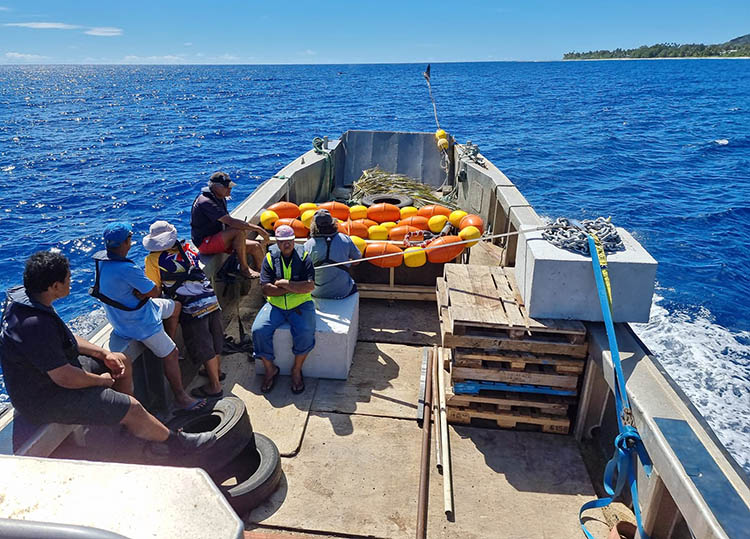Using technology to assist fisheries work, weather forecasting
Tuesday 25 October 2022 | Written by Supplied | Published in Environment, Technology

Aitutaki senior fisheries officer Richard Story led the team of Ministry of Marine Resources and local fishermen onboard the Te Kau barge skippered by George Koteka, to deploy a FAD in 2021. Picture: JUNIOR IOAPA/ 21091207
The Ministry of Marine Resources (MMR) and the Cook Islands Meteorological Service are working together to employ state-of-the art technology to further their understanding of fisheries and assist with forecasting the weather.
MMR and the Met Service are collaborating with the Pacific Community (SPC) for the HI-FAD (Highly Instrumented Fish Aggregating Devices) Project, which includes deploying a variety of monitoring buoys on anchored fish aggregating devices (FADs) around Rarotonga and Aitutaki.
FADs are used by local small-scale fishermen, and this project will investigate whether they can also be used as a platform for ocean monitoring sensors to further assist fishers and improve the forecasting of ocean conditions, a statement from MMR said.
According to MMR, three types of solar-powered buoys have been deployed on various FADs, including wave buoys, echo-sounders, and GPS trackers. All three types are equipped with internal GPS monitors.
- Wave buoys are used to provide real-time or “live” monitoring of wave conditions, which will be used by the Meteorological Service to improve local and regional ocean and weather forecasting, as well as providing information to FAD users about the current weather conditions at that particular FAD.
- Echosounder buoys are equipped with an acoustic sensor that can detect fish underneath the buoy from the surface to a depth of about 120 metres. Another interesting feature of these buoys is they can estimate the amount of biomass underneath the FAD, which could give fishermen an idea of what’s swimming below the surface. These buoys have been successfully used on drifting FADs, and this project will test whether they can also work on anchored FADs. This buoy will be deployed at the Panama FAD in Rarotonga.
- The GPS-tracking buoys are being trialled as a lower-cost alternative to previous designs. These can be used to locate FADs and recover them when they break off, reducing economic losses from broken FADs while also reducing marine pollution.
“MMR asks FAD users to not tie their boats to the buoys or interfere with their movements. Additionally, if a member of the public finds a buoy that is detached or damaged, we ask them to please return it to MMR’s main office in Avarua.”












































